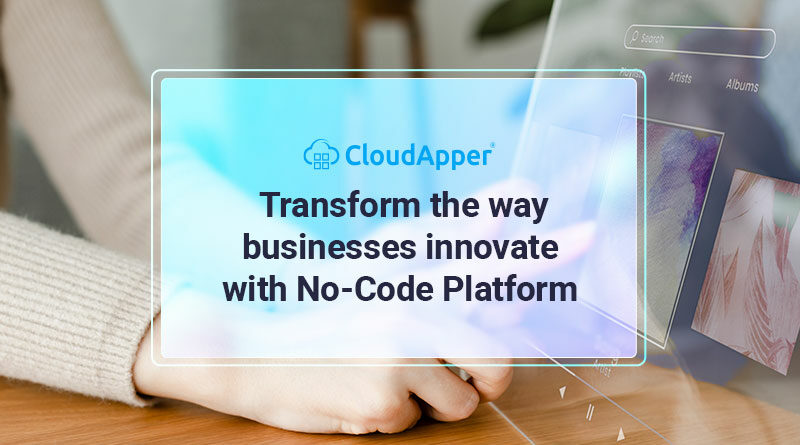No-code has the potential to transform the way businesses innovate
John Lennon and Paul McCartney are two of the greatest songwriters in music history. Without their contributions, pop music as we know it would not exist. As a result, it’s even more remarkable that neither of the Beatles could read music before recording their songs on vinyl. Instead, they learned each song’s chords. This shows an important point: for creativity to grow, all it needs is a means of expression, not formal instruction.
The democratization of technology has caused a fundamental shift in how we manage, encourage, and feed innovation in our organizations. Thanks to no-code technologies, many organizations may now apply this lesson to their systems. These technologies enable anybody, regardless of programming knowledge, to develop apps. It has existed since the 1990s, but cloud services and enterprise-grade software development are just now bringing these technologies to the masses. According to Forrester, low-code/no-code platforms will account for 75% of new app development by the end of 2021.
Unleash the exceptional by automating the routine.
There are various compelling use cases at this early stage of adoption. The most apparent use for no-code is the automation of transactional procedures. Non-programmers may become programmers by using No-code, allowing them to automate routine tasks and get more out of the products they use every day.
On the other hand, no-code seeks to unleash the extraordinary while also automating the mundane. In today’s digital economy, keeping up with the competition and adjusting swiftly is essential for an organization. As a result, apps must be updated, published, and improved regularly.
The fast lane of innovation
No-code benefits both professional and citizen developers by allowing for rapid innovation. No-code tools allow the quick creation of prototype interfaces or processes, which speeds up and simplifies agile sprints. Developers may use no-code as a foundation for prototypes and then add complete coding afterward.
Because of a shortage of experienced coders, a company’s professional developers may be overworked. To address this issue, a new breed of citizen developers capable of sharing the load is being formed using low-code / no-code techniques. Professional programmers also benefit from No-code since it decreases their workload.
They are the organization’s Bach and Beethoven, arranging complicated code lines to produce advanced functions and algorithms that can only be obtained by years of hard labor and formal education. They are our Lennons and McCartneys when it comes to creating beautiful and crucial programs that may change the world yet needless work from our other employees. Developers may be liberated by no-code, but it also breaks a monopoly on invention.
How to implement in a no-code manner
No-code is a trend that companies cannot afford to ignore. This would put the firm at a competitive disadvantage in the long run. What factors should the CIO and other company leaders bear in mind while implementing a no-code strategy? In my perspective, there are several crucial factors:
Examine the purchase vs. construction trade-offs in depth. For some time now, commercial off-the-shelf (COTS) solutions have gained momentum on in-house application development. This is due to the fact that there is no code. There is still a strong argument to be made for using commercially available software in systems that directly affect the customer, employee, or business partner experience. However, major software providers are aware that consumers will no longer wait six months to create and deliver new features; instead, they expect new capabilities to be accessible instantly, and no-code features can help manage this expectation.
Talent journeys may be plotted. The use of no-code improves the number of individuals who can work on apps. Non-coders must be trained to get the most out of their software. Citizen developers will need to be taught how to think like traditional developers and architects and how to reuse common services and functionalities, even if great technical skills are not always required. For the time being, past generations of developers’ knowledge and experience earned from working on legacy systems like mainframes and midranges may be used to prepare them for a career in the no-code, cloud-first era.
Install guardrails for your safety. It is impossible to overestimate the value of both security and reusability. If you want your workers to use the same authentication provider for all of the apps they are creating, you must give some control. To build standardized frameworks that citizens developers may use by default, I recommend using no-code solutions that allow tool customization.
The race is won by going slowly and steadily. Allow yourself plenty of time to iron out any issues in your first few no-code deployments before they become a significant issue. As your citizen developers and IT professionals gain proficiency and knowledge about potential use cases, the no-code application and its features may be enhanced. This extra time is beneficial for more complex challenges like security, data management, and reusable authentication components. Those who take their time will always win the no-code race.
Listen to the song and choose an instrument that suits it. You wouldn’t use a drum for a guitar solo, and you shouldn’t use no-code to build custom systems all the time. Using no-code as a development platform may substantially benefit the creation of apps for departmental usage. It’s also an excellent choice for creating more complex, enterprise-level programs. Adding more complicated parts or capabilities, on the other hand, typically involves the use of professional coding tools such as Visual Studio.
Lennon and McCartney transformed the landscape of popular music because they were allowed to express themselves freely. Enterprises now enable their workers to accomplish the same thing in a corporate context using no-code. I’m looking forward to seeing what they come up with! The fact that the digital revolution is still in its early stages continues to excite me.











